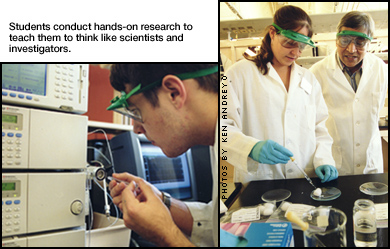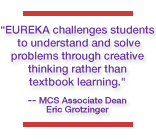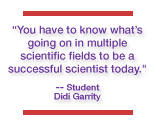|
|
||||
|
|
First-Year Students Use Science to Solve Fictitious Murders
The Mellon College of Science (MCS) is offering a unique interdisciplinary science course for 20 first-year students this semester that culminates with a forensic study to solve two fictitious murder cases. Called "EUREKA: An Interdisciplinary Laboratory Experience," the course combines the academic disciplines of biological sciences, physics, chemistry and mathematical sciences.
"We think that EUREKA-like courses are relatively rare nationwide because most undergraduates do not conduct laboratory work in all four disciplines in their first year," said MCS Associate Dean Eric Grotzinger, one of the developers of the course. "By highlighting the interdisciplinary aspect of today's scientific world, the course prepares students for the complex challenges they will face as scientists. EUREKA challenges students to understand and solve problems through creative thinking rather than textbook learning."
EUREKA, offered only to first-year students in MCS and the Science and Humanities Scholars (SHS) program, consists of two components: lecture and laboratory work. Each week, a guest speaker delivers a lecture that highlights issues in interdisciplinary science. The first speaker, Carnegie Mellon President Jared Cohon, spoke on water quality problems arising from combined sewer overflows in Western Pennsylvania. In another guest lecture, Gordon Rule, associate professor of biological sciences, illustrated how scientists use physics, mathematics, biology and chemistry to explain the activity of green fluorescent protein (GFP), an essential component of modern cell biology research and the substance that makes some jellyfish fluoresce.
A second research group is comparing the way light affects different dyes to explore how light can be used to gather structural and quantitative information about molecules. Capturing this information is crucial in developing substances such as new drugs and industrial polymers. A third group is exploring the conversion of light into heat or motion, the manner in which light affects the growth of some plants, and the human eye's response to light. Such work is vital in developing new energy technologies—solar panels, for example—and in understanding how living things interact with light.
Students rotate into different research groups over the course of the semester, allowing them to work on two of the three projects. The experiments chosen for the three research groups illustrate how similar investigative techniques can be used across scientific disciplines.
In all three groups, students formulate their own research questions and devise their own strategies for arriving at answers, an unusual approach for a first-year course. A goal of the course is to heighten the students' scientific curiosity and to teach them to think like independent investigators and scientists, according to Stephen Garoff, a EUREKA instructor and professor of physics.
EUREKA culminates in students using forensic techniques culled from their lab experience to solve the hypothetical murders of two professors in a fictitious Carnegie Mellon department. In this forensic exercise, written by Professor of Mathematical Sciences Russell Walker, students will analyze tire tracks, paint, fingerprints, gun shot residue and DNA evidence to solve the crime. At the end of the semester, students will hold a mock trial to present the evidence they have gathered.
David W. Platt
|
||
|
Carnegie Mellon Home |
||||

 Didi Garrity, a EUREKA student interested in pursuing a career in biology, said that learning how different scientific disciplines intersect and complement one another is vital. "The bar is constantly being raised. You have to know what's going on in multiple scientific fields to be a successful scientist today," she said.
Didi Garrity, a EUREKA student interested in pursuing a career in biology, said that learning how different scientific disciplines intersect and complement one another is vital. "The bar is constantly being raised. You have to know what's going on in multiple scientific fields to be a successful scientist today," she said.
 In the laboratory, students are divided into three groups working on three separate research problems. One research group is isolating bacterial DNA from a variety of soil samples and amplifying two regions of the genome by polymerase chain reaction (PCR) to study biological diversity. DNA isolation and PCR are used in areas such as forensic criminal investigation and biomedical research.
In the laboratory, students are divided into three groups working on three separate research problems. One research group is isolating bacterial DNA from a variety of soil samples and amplifying two regions of the genome by polymerase chain reaction (PCR) to study biological diversity. DNA isolation and PCR are used in areas such as forensic criminal investigation and biomedical research.